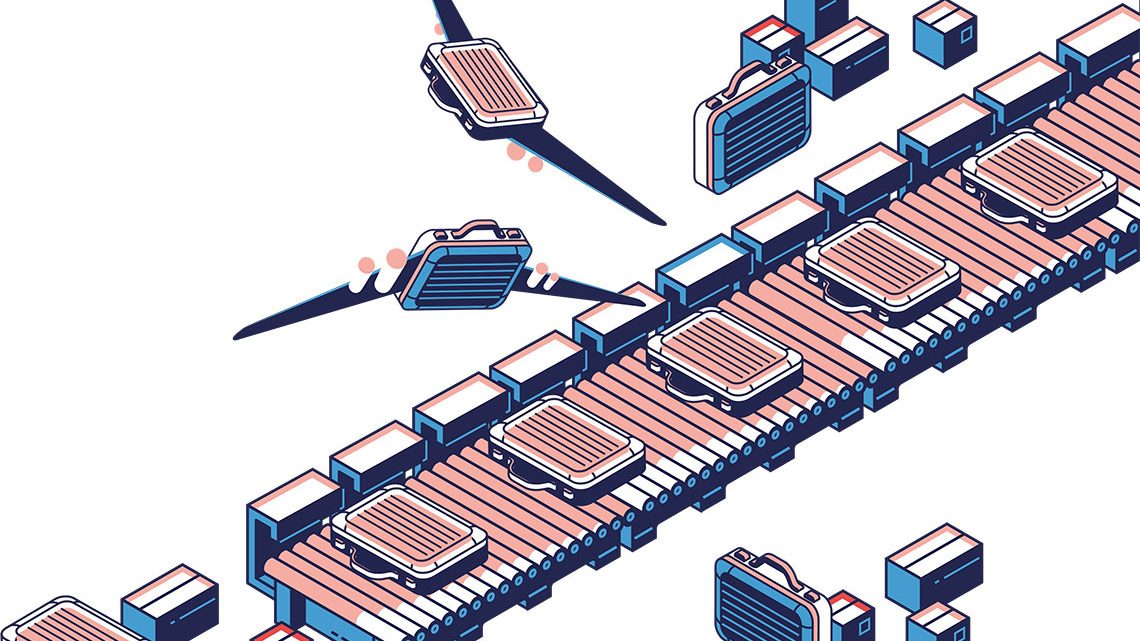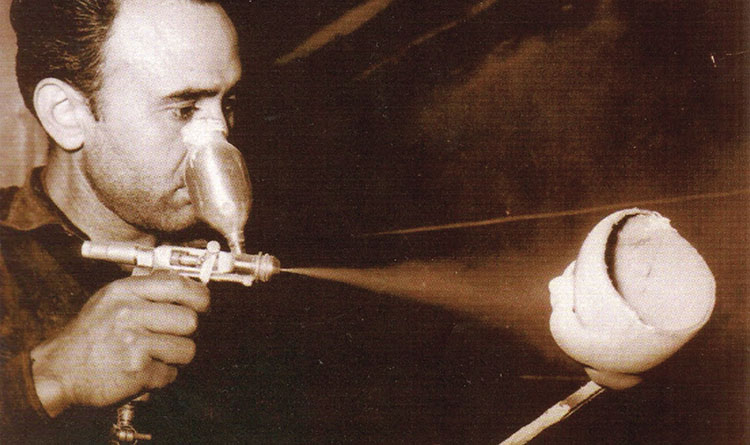checking in our suitcase
The big day is finally here! It’s time for us to fly. We leave everything neat and tidy at home, pick up our suitcase, and head to the airport. When we get to the terminal, we make our way to the check-in desk, where we witness the first stage in the journey taken by our baggage: tagging.
The tag serves to identify our baggage in the BHS, and normally consists of a sticker bearing a series of printed details and a barcode. This sticker is usually wrapped around the handle of our suitcase. The barcode, by the way, is a unique reference and ensures that every item of baggage has its own exclusive identification code.
In addition to the tag, at the same check-in desk the size and weight of our suitcase is checked automatically. After the tag has been attached, and provided the suitcase is within the permitted dimensions, it enters the BHS.
BHS stands for Automated Baggage Handling System, and comprises a series of elements that convey our baggage automatically from the check-in desk to the point of delivery to the handling agents, who are responsible for loading it onto the plane. (See Figure 1).
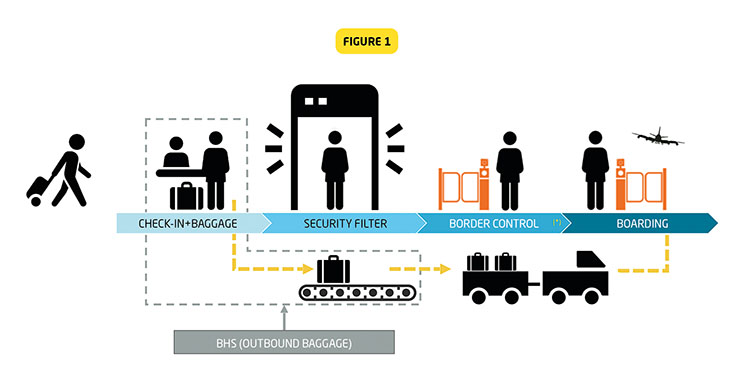
BHS. A series of elements that convey our baggage automatically from the check-in desk to the point of delivery to the handling agents.
Our suitcase makes its way into the BHS
Our suitcase enters the system via a series of automated conveyor belts. It leaves the airport’s check-in area and is taken to a technical and rather industrial area within the same building. The suitcase is now one of many that are currently within the system, and are being conveyed in an orderly fashion along the multitude of conveyor belts that snake their way through the facility.
The BHS controls the progress of the baggage using Programmable Logic Controllers, or PLCs. These devices govern various elements within the system, including the motors that move the conveyor belts, and decide whether to start or stop each motor based on the prevailing conditions within the system at the time.
Our suitcase continues to make its way along the conveyor belts and soon passes through a gate, which is fitted with several strategically positioned laser barcode readers. This gate is known as the Automatic Tag Reader (ATR).
Scanner arches enable the BHS to identify the suitcase by reading the barcode that has been attached to it. Once it has been identified, the BHS assigns the suitcase a final destination within the system. It should be noted that the BHS is able to distinguish between suitcases based on the flight they correspond to, thereby ensuring that baggage for the same flight is delivered to the same end point (i.e. the make-up carousels).
At no point has our suitcase stopped in order to be identified as it made its way through the Automatic Tag Reader. The transit process is continuous, except for a couple of occasions when the system stopped the suitcase at a junction, so that an item of baggage from another line ahead of us could join the belt.
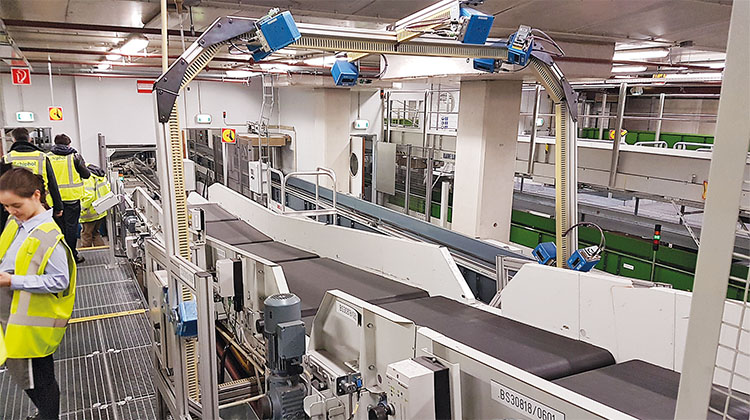
Ineco is currently working on the design of the BHS for the international airports of Schiphol (Amsterdam), pictured, and Dammam (Saudi Arabia). / PHOTO_INECO
Baggage inspection
All of the baggage that enters the BHS is inspected, in order to ensure the safety and security of people, aircraft and the airport facilities. Our suitcase continues to make its way along the conveyor belts, heading towards a large machine in the distance that appears to be swallowing up all of the baggage in front. This is the baggage screening machine.
Baggage screening machines examine every single item of baggage that enters the BHS. They are equipped with advanced technological features designed to detect elements that might cause harm to people and property, such as weapons and explosives.
A small curtain marks the point where the inspection process begins. As with the identification process, our suitcase does not stop during the inspection process, and after a few seconds it emerges from the machine and passes through a second curtain before continuing its journey through the facility.
At the end of the inspection, the machine sends the result to the BHS, which incorporates this result into the data it has for the item of baggage in question. This data is vital, as the BHS must ensure that the only suitcases to reach the planes are those that have been ‘cleared’ (i.e. they have passed the inspection).
So, with the inspection result now linked to its data file, our suitcase continues on towards a critical decision-making point in the system. Here, there is an electromechanical device that separates the ‘cleared’ baggage from the rest, sending it along one belt and the ‘non-cleared’ baggage along another.
At this decision point, the BHS is able to verify the inspection status of each item of baggage. If –and only if– a suitcase’s status is shown as ‘cleared’, the system will allow it to continue on towards the final destination. In all other cases, the system will divert the baggage so that an additional inspection can be carried out.
As our suitcase does not contain any dangerous items, it was ‘cleared’ during the first inspection and can now make its way to the final destination. Behind it, at the decision point, other suitcases that were not so lucky are diverted onto a different line, where they will be subjected to a new inspection.
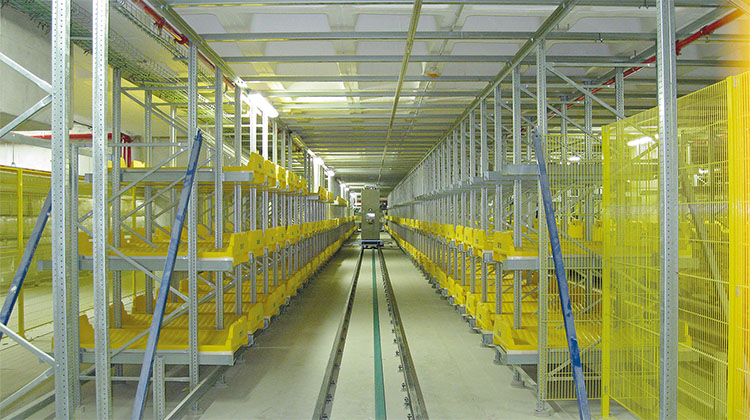
Early baggage storage line with stacker crane operation, Alicante airport. / PHOTO_JOAQUÍN ESTEVE
Baggage classification and final destination
Because it classifies baggage by flight, the BHS helps to make airport operations more efficient. Our suitcase is now nearing the end of its journey. The line it is now travelling on has a multitude of junctions leading off to different locations, such as early baggage storage, manual encoding stations, make-up carousels, and docks for ‘problem’ baggage.
Early baggage storage is a temporary destination for baggage that has been introduced into the system but whose flight does not yet have an assigned make-up carousel. It is a sub-system that is of tremendous help to airports that handle high volumes of baggage for connecting flights, when there can be a difference of many hours between the arrival and departure flights.
Our suitcase continues on past the entrances to the manual encoding stations, as the BHS has not lost track of it at any point. It also goes past the entrance to early baggage storage: the make-up carousel for our flight is now ready to receive baggage, so there is no need to store the suitcase within the system temporarily. When our suitcase reaches the junction for the make-up carousel assigned to our flight, the system activates a switch to send it along the right track. During this final stage in its journey, the baggage is carefully deposited onto the make-up carousel.
Make-up carousels are electromechanical elements that form a closed circuit, into which all the baggage for a particular flight is deposited. The baggage trains are positioned alongside the make-up carousels, in order make the process of loading the baggage onto the trains as efficient as possible.
Once the suitcase has reached the make-up carousel, it is out of the hands of the BHS and becomes the responsibility of the handling agent. Via the baggage train, the agents transport our suitcase to the plane and load it into the hold. Sometimes, if we look through the plane window, we can see this process taking place.
Summary and final thoughts
Figure 2 shows the processes that a suitcase passes through after it has been checked in.
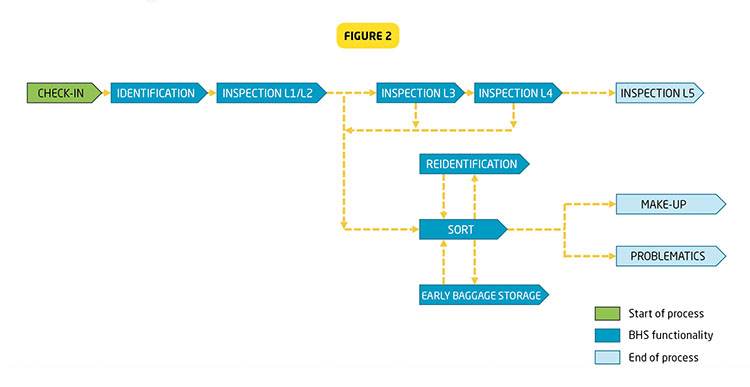
DIAGRAM OF AN OUTBOUND BAGGAGE SYSTEM. This diagram shows all of the processes that a suitcase passes through, from its arrival at the check-in desk to the final destination of the loading dock, where it passes out of the hands of the BHS and becomes the responsibility of the handling agents.
The BHS has a number of technical solutions, contains many more elements and carries out many more processes than those described in this article. Ineco is aware of this complexity and takes the specific nature of each project into account. This enables the company to provide tailored services for the domestic and international markets.
BHS: a key role in baggage handling
Roberto Calonge, industrial engineer at Ineco and an expert in BHS and ORAT
Baggage Handling Systems (BHS) are among the most complex and extensive facilities within the airport terminal. Their transport systems can reach extreme lengths (for example, the BHS line at Terminal 4 in Adolfo Suárez-Madrid-Barajas Airport is over 80 kilometres long, while the line at Terminal 1 in Josep Tarradellas-Barcelona-El Prat Airport is over 20 kilometres long), while some systems can process more than 5,000 items of baggage in a single hour. Moreover, the constituent elements of the system extend to almost every level and area within the terminal building.
The dimensions of the system are so staggering that industry experts often describe an airport terminal as an BHS with a building on top. Hyperbole aside, an BHS plays a key role in handling checked baggage and is designed to ensure that each passenger’s suitcase is loaded into the hold of the correct plane on time and is delivered to the passenger as quickly as possible at the destination airport, while observing all of the necessary security procedures along the way.
In all of the terminal design projects in which it has taken part, Ineco has addressed the need to design an BHS (in terms of both transportation system layout and technology) that is adapted to suit the specific operating needs of each airport. For example, the design of an BHS for a hub airport such as Schiphol focuses on minimising the processing time for baggage on connecting flights, in order to ensure that those with a short space of time between flights (‘hot transfer bags’) are processed quickly, while those with longer connection times are temporarily placed in an early baggage storage (EBS) until they can be made-up for the flight, i.e. loaded onto baggage trains or placed in containers to be taken from the terminal building to the plane.
In the case of Schiphol, a combination of transportation technologies were chosen: conveyor belts for baggage that does not need to be transferred between terminals, and an ICS (Independent Carrier System) for baggage that does, as an ICS allows for greater speed and tracking precision than a conveyor belt system. In contrast, for an origin/destination airport such as Kastelli on the island of Crete, the design focuses on minimising the transportation time between the check-in desks and the make-up carousels.
Designing a successful BHS –and the success of the baggage handling process as a whole– always hinges on understanding the interests of the actors involved. The following two examples help to illustrate this point: at Rosalía de Castro-Santiago de Compostela Airport, it is necessary to provide automated transportation for bicycles between the check-in desk and the baggage train area, as bicycles are a mode of transport used by pilgrims. Meanwhile, at Costa del Sol-Málaga Airport, it is necessary to provide transportation for golf bags, as golf is one of the activities that draws visitors to the area.
The future of the industry will involve new baggage identification and tracking systems, which may even use computer vision and artificial intelligence
When designing airport terminals, Ineco –which has a team of BHS experts– takes the operation as a whole into account, in order to ensure that the needs and expectations of the actors involved are satisfied in full. The baggage handling process at an airport is an example of a supply chain in which various organisations are responsible for particular parts. Consequently, efficient design throughout the transportation chain –and especially for the interfaces between sub-systems– is vital in order to ensure that every item of baggage is delivered to its owner without unnecessary delays at the destination.
The design of an BHS must therefore enable the efficient transportation of baggage while minimising capital expenditure and the costs of operating and maintaining the system. It must also ensure that the system is available almost 100% of the time, and that the baggage is transported to the correct make-up carousel. In order to achieve this latter aim, a high degree of precision is required to identify each item of baggage (by reading the data on its tag) and track it as it moves through the facility before final delivery to the make-up carousel.
For the ramp handling companies, which are responsible for loading the baggage onto the carts and containers, transporting it to the aircraft and loading it into the hold (and vice versa), the operational logic of the BHS must take the working requirements of each company into account. For example, one company may require that flight make-up begins 120 minutes before departure, while another requires that it begins 150 minutes before departure. It is also necessary to ensure an ergonomic design for the baggage loading and unloading operations.
Lastly, hold baggage represents an important part of an airline’s business, as passengers may have to pay for each item of checked baggage. (This can be an extremely important factor for airlines that follow a low-cost model.) Baggage that is not delivered to the passenger at the destination airport has a high cost for the airline, as locating and sending the baggage to the passenger’s home can multiply by a factor of 10 the amount of work needed to transport baggage under normal conditions; additionally, there is the risk of losing the passenger as a customer for future flights.
The baggage handling industry is an extremely dynamic one, undergoing constant evolution in order to introduce new technologies that can help to deliver baggage to the passenger at the destination airport as efficiently and cost-effectively as possible, while minimising the environmental impact. Ineco has been a witness to (and continues to take part in) this evolution and has worked on each stage of a number of BHS projects: process planning and drawing up the basic and detailed designs for the system; developing the technical specifications and bid assessment criteria; monitoring and supervising construction; Operational Readiness and Airport Transfer (ORAT), including the development of operating and contingency procedures; operational testing and monitoring, maintenance, and process reengineering.
At present, the industry is undergoing a revolution in terms of the technologies and business models used, which Ineco is able to introduce into its designs when necessary. Noteworthy examples include:
- Obligatory baggage tracking at a minimum of four points (check-in, loading onto the aircraft, unloading at the transfer area, and delivery to the passenger), in accordance with IATA Resolution 753.
- The gradual implementation of baggage identification and tracking using RFID technology (as IATA has indicated to its members) and OCR identification, both of which are designed to support the traditional process of identification and tracking by reading the barcodes on the bag tags. Some companies are even developing identification and tracking processes based on computer vision and artificial intelligence.
- The extension of the baggage handling process beyond the airport, with check-in and final delivery taking place off-terminal, so that passengers do not need to hand over or pick up their baggage at the terminal.
- The introduction of self-service models for both baggage check-in and delivery to the passenger at their final destination.
- The use of XML-based messaging between the BHS and the airlines’ DCS systems, in order to make communication between the two systems more reliable.
- Automation of the tasks of loading and unloading baggage, including autonomous vehicles thereby reducing the risk of injury to the handling agents when they perform these tasks.
- Providing passengers with real-time information on the status of their baggage via the airlines’ own apps.
The emerging ideas that are being developed in the industry, and which Ineco is following with a view to incorporating them into its projects, include the de-linking of the itineraries of the passenger and their baggage, in order to make better use of aircraft hold space; the use of e-commerce distribution networks within cities to transport baggage from the passenger’s home to the airport terminal, and vice versa; and the possibility of processing hold baggage at air cargo terminals.
The company has a team of experts that specialise in BHS and airport baggage handling, with extensive experience of projects at varying scales and with different operational requirements. The team has worked with a variety of technologies and business models and has the capacity to design the most efficient handling system for each airport, including BHS.
The new baggage identification and tracking systems (including those that use computer vision and artificial intelligence), automation, and the extension of the check-in and delivery processes off-terminal, are just some of the examples of the revolution that the industry is currently undergoing.


